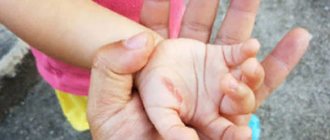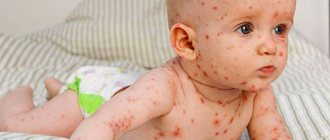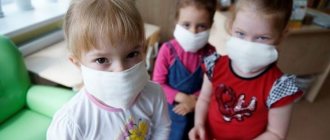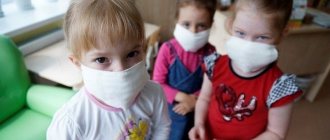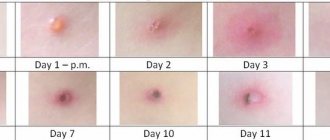Chickenpox or varicella is an acute infectious disease caused by viruses of the herpes family. A distinctive feature of chickenpox is a rash on the skin in the form of small blisters.
Almost all children aged 2 to 7 years old suffer from chickenpox, especially if they attend kindergarten, since the pathogenic virus is very volatile and can penetrate not only into adjacent rooms, but also into apartments. In addition, a large percentage of the incidence of chickenpox in children is due to the fact that the latent period of the disease is 14-21 days, due to which the virus has time to spread and cover all children in the group or kindergarten. The chickenpox virus ceases to act until the last rash ends, that is, the virus stops being transmitted when the last blisters begin to heal.
Children under 6 months of age do not get chickenpox, since even during the prenatal period the baby’s mother passed on her immunity to him. Children over 7-10 years old get chickenpox less often, but if they do get sick, the infection is quite severe with possible complications.
How does chickenpox begin in children?
The causative agent of chickenpox is transmitted by airborne droplets. The source of the virus is a sick person. It is worth noting that the Varicella zoster virus, in addition to chickenpox, causes herpes zoster; in case of contact with a patient with herpes zoster, it is also possible to get chickenpox. The spread of pathogenic microorganisms occurs when talking, coughing, sneezing, etc. Air currents can carry active viruses over a distance of up to 20 m. That is why children who are often in groups, attending kindergartens and studying in schools are more susceptible to infection. During the period of treatment of chickenpox in children, preschool and school educational institutions are closed for a three-week quarantine.
The virus, entering the child’s body through the mucous membrane of the upper respiratory tract, does not make itself felt for 2-3 weeks. At the end of the incubation period, the disease signals itself with the appearance of the first symptom—fever. It is worth noting that an increase in temperature is not a mandatory sign of chickenpox and is not observed in all children.
About the next day after a sudden rise in temperature, a rash appears on the child’s body. The first rashes are most often located on the scalp, so they may go unnoticed by parents, especially if the child’s hair is thick and long. In order to prevent secondary bacterial infection, it is recommended to treat rashes with antiseptic agents (for example, creams containing zinc or brilliant green). A day or two after their appearance, the watery blisters on the skin burst, then they dry out and crusts form in their place. The rash may be accompanied by severe itching, which bothers the child. In this case, the doctor may recommend antihistamines. In general, the skin rash stage lasts from three to seven days.
Chickenpox incubation period: symptoms and treatment of the disease
Chickenpox, commonly known as chickenpox, is a highly contagious viral disease. The disease is easily diagnosed and treatable, especially in childhood.
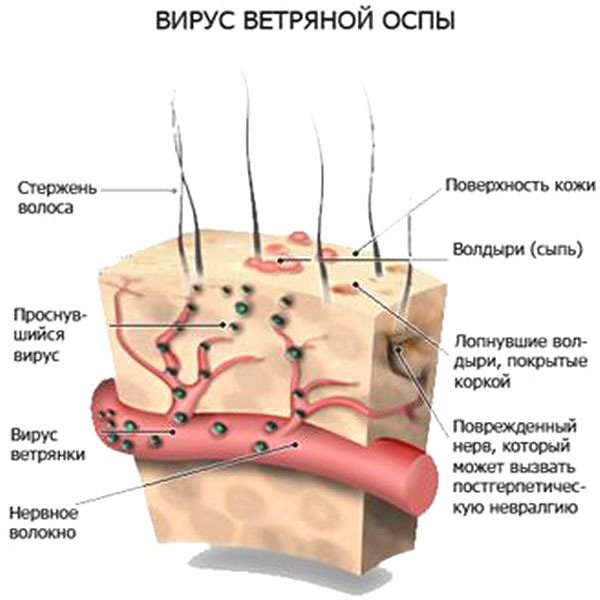
The disease is characterized by the following clinical picture:
- rashes;
- itching of varying intensity;
- chills;
- elevated temperature;
- headache;
- lack of appetite;
- enlargement of regional lymph nodes.
We invite you to read Diaper rash in a child: 9 most common causes. How to treat diaper rash in a child
The rash is blisters that fill with fluid after some time (about 2 days). After another 2 days the latter becomes cloudy. After this, the bubble begins to dry out and turns into a crust.
Dried crusts disappear after some time - after about 1-3 weeks.
If treatment with antiseptics is carried out correctly and regularly, then no scars remain after the crusts come off. In the absence of antiseptic treatment, secondary infection occurs with the involvement of the germinal layer in the pathological process. As a result, traces remain.
The causative virus is very weak: it dies quickly, has little stability in the external environment, is easily destroyed by disinfectants/UV, and dies from low/high temperatures.
At room temperature, it lives for a short period - only a few hours. But it is volatile - it can travel about 20 m. However, it very easily enters the body, even with fleeting contact.
Most cases of the disease are registered in the autumn-winter period in children 5-10 years old. Adults who were not sick in childhood become infected easily, but suffer the disease much more severely than children.
The duration of the incubation period varies from 10 to 21 days. Moreover, this period is not exact: in adults, the first symptoms may appear a little later, and in weak children - earlier.
- In medicine, it is believed that the average incubation period lasts for children - 14 days, and for adults - 2 days more.
- During the incubation period, the virus spreads through the upper respiratory tract, actively multiplies, penetrating the epithelial cells of the mucous membranes.
- The entire incubation period is divided into several stages:
- Direct infection, adaptation of the pathogen in the human body;
- Then follows the second stage of the incubation period - reproduction and accumulation of the virus, the formation of the primary focus of infection and its peripheral spread;
- The spread of the pathogen throughout the body, the production of antibodies to the foreign agent by the immune system, and the appearance of the first symptoms of the disease.
When the incubation period has passed, the first thing that happens to an infected person is pink nodules on the face and scalp. In a matter of hours, the rash spreads to other parts of the body, including the skin between the fingers and even mucous membranes (mouth, genitals, eyes). Particularly sensitive areas itch.
Rashes with fever are observed for about a week or 10 days. Then the crusts disappear and the skin becomes clean again.
After a person has had chickenpox, they develop lifelong immunity to this virus.
Infants without antibodies do not tolerate the disease well. They have severe symptoms of intoxication, and there is a high probability of bacterial and other complications.
How can you get infected?
The virus is transmitted only in one way - airborne droplets. It cannot be “picked up” through household items, etc. If the blisters are opened, there is a small chance of infection through the skin. The contagiousness of the disease is very high, but you can protect yourself by simply not communicating with a sick person. There is no need to completely disinfect the entire house.
How many days is the patient contagious?
An infected child or adult becomes contagious 10 days before the first symptoms of the disease appear. It is from this moment until all the crusts disappear that he can transmit the disease to others. That is, the period of contagion can reach 3 weeks.
How to avoid getting chickenpox?
In order not to “catch” the disease, you should not allow contact with infected people: you should stop visiting the team where the outbreak of the disease occurred. For example, you should not take your child to kindergarten for a certain time if there is a quarantine there. Protective masks do not guarantee complete safety.
According to most doctors, it is better to get chickenpox in childhood. Teenagers and adults tolerate smallpox worse, their temperature rises greatly, and other complications arise.
The risk of negative consequences in the absence of vaccinations (non-immunized people) is very high. The disease is dangerous for pregnant women (there is a high probability of disability for the unborn child) and for infants whose mothers are not vaccinated. In such situations, a complicated form of the virus may occur: bullous, hemorrhagic, gangrenous.
Hospitalization of the patient is necessary only in case of complications of the disease or its severe course.
Therapy is usually carried out at home.
- During the treatment period, adhere to bed rest;
- Caring for affected skin/mucous membranes to prevent complications;
- Daily bath and change of linen;
- Treatment of each element of the rash with a solution of brilliant green 1%;
- If the oral mucosa is affected, after each meal, rinse with a decoction of chamomile, calendula, furatsilin solution, or at least ordinary boiled water;
- In case of eye damage, purulent discharge, instillation of sodium sulfacyl 20-30% is done;
- Antipyretics, for example, Panadol and Nurofen syrups for children, paracetamol tablets for adults, will help reduce the temperature;
- The patient is advised to drink plenty of fluids;
- For severe itching, antihistamines are required, for example, Diazolin, Suprastin, Tavegil.
If you suspect chickenpox, you should call a doctor at home. This will avoid infecting others and will not worsen the condition of the patient himself.
If necessary, the doctor prescribes immunocorrective and cytokine drugs. Treatment is supplemented with multivitamins, vitamin-mineral complexes, probiotics, and enterosorbents. If there is a cough, expectorants or mucolytics are prescribed.
Viricidal drugs
This includes abnormal nucleosides (Acyclovir, Valacyclovir, Famciclovir). Acyclovir will only be effective if it is started when the disease is just beginning to appear. The course of treatment lasts up to 10 days. Acyclovir ointment is applied to the rash sites.
- Valaciclovir can be used from the age of 12, and Famciclovir can be used from the age of 17.
- Interferon preparations
- The doctor may prescribe tablets or rectal suppositories: “Viferon”, “Genferon light”, “Kipferon”.
Candles are placed twice a day for up to 10 days in a row. Children under 7 years old can use Viferon 1, older children can use Viferon 2. You can also treat elements of the rash with Viferon ointment.
Interferon inducers
From a group of such, the doctor can prescribe “Neovir”, “Kagocel”, “Poludan”. Poludan is suitable for body treatment.
Severe disease requires the use of IVs and the use of potent drugs. Of course, such treatment is carried out only in a hospital. Doctors supplement it with immunoglobulins. In case of complications of chickenpox (development of gangrenous, pustular, bullous forms), antibiotics are prescribed.
Vaccination is the most reliable way to protect against chickenpox. But it is not considered mandatory, it is carried out only at the request of the parents. Vaccination helps prevent the disease, but if a child does get sick, chickenpox is mild.
Some parents refuse vaccination, explaining that it is better for the child to get over chickenpox before school. It is believed that children will quickly cope with the disease and gain protection for the entire time.
But experts refute the arguments of young mothers, arguing that a baby who has recovered from the disease may still have the herpes virus, which in the future can cause the appearance of shingles. Therefore, decisions regarding vaccination should be balanced and well thought out.
Clinical picture of chickenpox
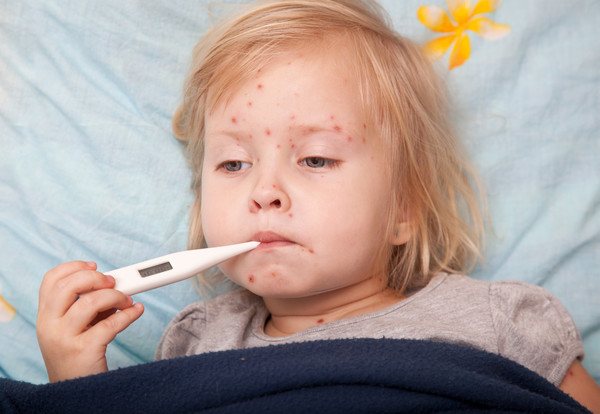
The incubation period for chickenpox varies from 7 to 21 days. From the moment the virus enters the mucous membrane of the upper respiratory tract, the prodromal period begins - that is, a nonspecific period of illness, when symptoms such as lethargy, moodiness, decreased appetite, and general malaise may appear. However, often the prodromal period is not expressed and the rash, a characteristic symptom of the disease, appears against the background of complete health, which is sudden and unexpected for parents.
The period of rash is the main clinical symptom complex of the disease. The rash occurs due to the multiplication of the virus, and is accompanied by high fever, general weakness, muscle pain and headache.
Atypical forms of chickenpox
Atypical chickenpox in children and adults is a type of disease that occurs with a very pronounced clinical picture or with its complete absence. Classification of chickenpox manifests itself in the following forms:
- meningoencephalitis;
- rudimentary;
- gangrenous;
- generalized;
- hemorrhagic.
The manifestation of chickenpox in such forms often causes serious complications that can threaten the life of the patient.
Meningoencephalitic form
Shingles is caused by the same virus as chicken pox, or rather its degeneration. Many painful blisters with purulent contents appear on the body of the infected person. Pathology manifests itself in previously ill people. Varicella Zoster after treatment goes into a latent state, but is not completely eliminated from the body. Thus, provoking factors cause the chickenpox virus to wake up again in a modified state. Causes of meningoencephalitic form:
- immunodeficiency;
- old age;
- chemotherapy, radiotherapy;
- tuberculosis;
- diabetes;
- diseases of the circulatory system;
- organ transplantation.
The disease is serious and difficult to treat. Causes hallucinations, impairs coordination of movements, reduces motor activity. After 6-20 days, the rash moves to the brain, and coma occurs. The mortality rate of patients is more than 60%.
Vestigial appearance
Gangrenous form
In newborns, a rudimentary form of chickenpox most often occurs. This is the mildest type of disease, almost always occurring without complications. Sluggish chickenpox in children may not show symptoms or have a mild clinical picture. The rash is practically invisible and does not transform into blisters. The latent form of chickenpox in children may have a clinical picture of colds, with the appearance of a cough. Examination of the patient is still important, since the causes of cough may be the development of pneumonia.
Gangrenous type
The gangrenous form of chickenpox is characterized by the death of the epithelium around the vesicles. The rashes are large, with pus mixed with blood inside. After opening, the blisters are covered with a crust, which, after falling off, leaves deep ulcers. The sores do not heal for a long time. The causes of the condition lie in late diagnosis, lack of adequate treatment and treatment of the rash. The patient has symptoms of intoxication.
The gangrenous form of chickenpox is rare. People at risk are children and adults with immunosuppression. Treatment of the pathology is long and difficult. Complications manifest themselves in the form of sepsis, which quickly leads to death.
Generalized view
Chickenpox, which occurs in this form, is characterized by damage to internal organs. A similar type of chickenpox appears in people with severe immunodeficiency, when taking steroid hormones or antitumor drugs. An infected person experiences severe intoxication. The rash covers the skin and scalp. This is a severe form of chickenpox in children or adults with a high mortality rate.
Hemorrhagic form
Internal chickenpox occurs in children and adults with blood diseases in which clotting is poor. Pathology can be provoked by taking antitumor drugs and glucocorticosteroids. The disease occurring in hemorrhagic form is characterized by:
- frequent attacks of vomiting with blood attacks;
- filling of papules with blood;
- blood in urine;
- nosebleeds.
The disease is rare. It gives complications in the form of disruption of the blood supply, which results in oxygen starvation and death.
Treatment of atypical forms of chickenpox in children and adults is long; it is necessary to call an ambulance at the first signs of the disease.
Chickenpox symptoms
Chickenpox in children begins with a sudden increase in temperature, without any other symptoms - no runny nose or cough. Within a day, a rash appears on the child’s body, which literally spreads throughout the entire body before our eyes. Red small pimples appear as if new spots or outbreaks appear between existing ones.
The temperature can last from 2 to 10 days, on average 3-5, then returns to normal. The famous itching appears when pimples turn into blisters, in place of which crusts then form. If the crusts are not touched, the rash gradually disappears and recovery occurs without consequences. Because chickenpox is a virus, antibiotics are not effective against it and may even be harmful. As a rule, chickenpox in children does not require special treatment, but sometimes complications can occur.
Signs of chickenpox in infants
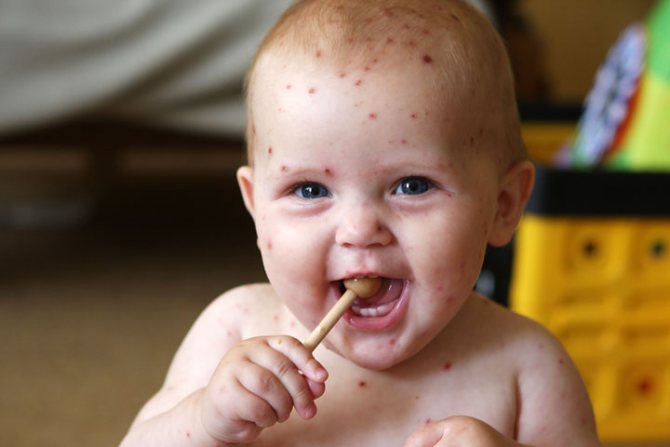
As already mentioned, for up to six months, the baby retains in the body the antibodies transmitted by the mother during pregnancy, so the general immunity during this period of the baby’s growth is strong. But in the future, while the baby develops his immunity, he can easily become infected with chickenpox. Babies whose mothers breastfeed are much more likely to resist infection. Chickenpox in children under one year of age has almost the same symptoms as in older children, namely:
- A rash in the form of mosquito bites appears on the baby’s body and face. It quickly spreads to the entire body;
- on the second day, the rashes turn into blisters with liquid inside;
- along with the rash, the baby’s temperature rises;
- lymph nodes enlarge.
After five days, the disease is no longer contagious, the rashes stop, and the acne gradually disappears. It is worth noting that in children the disease can occur in different ways: mildly, without any complications and with isolated skin rashes, or the disease torments the baby with intense heat and itching. The baby won’t be able to tell you anything yet, so he doesn’t sleep well, cries constantly, and refuses to eat.
In very severe cases, a rash appears not only on the skin, but also on the mucous membranes, and this brings unbearable suffering to both the baby and his mother. Therefore, it is very important to know how chickenpox manifests itself in infants in order to help your child.
What does chickenpox look like in children?
In order to detect and understand the first signs of chickenpox in children in time, it is important to know how the characteristic rash appears when the disease is in its initial stage. Therefore, each parent should know what chickenpox looks like in order to take the necessary measures in time.
After the incubation period expires - on the first day the child's temperature rises, after which a rash appears, which is a signal that the initial stage has developed (see photo).
Virus in ambush
The virus penetrates through the mucous membranes of the respiratory tract, mouth, and eyes. In this case, the incubation period (the period during which the virus, which has settled in the body, does not manifest itself in any way) ranges from 1 to 3 weeks. All this time the child feels great. It is believed that it becomes contagious a couple of days before the rash appears. And after 5 days from the moment the last bubbles appear, the virus loses activity and does not pose a danger to others.
The disease begins acutely. Many people experience high fever, weakness, headache, and aversion to food. But with a mild form of chickenpox, these symptoms are absent and there are no other manifestations other than rashes. First, red dots appear on the skin, similar to mosquito bites, which, quickly spreading throughout the body, swell into blisters filled with liquid. They can jump up on the head, and even on the mucous membranes of the mouth and genitals. As a rule, they do not occur only on the feet and palms. After a couple of days, the blisters dry up, but others appear in their place: new rashes can appear within 4–8 days from the onset of the disease. Then the disease subsides.
Chicken pox in children - Treatment
Chickenpox treatment is only symptomatic. It consists of reducing elevated body temperature and relieving the unbearable itching of the rash using antipruritic medications prescribed by the doctor and applied to the skin. You should minimize your child's scratching of the bubbles. To do this, cut the baby’s nails, and at night put cotton gloves on his hands. During this period, it is also necessary to change linen and bedding daily and wipe the blisters with antiseptic liquids to reduce the incidence of bacterial infection.
During the period of illness, the baby should be calm, drink plenty of fluids and eat healthy foods. If complications from chickenpox appear, then the baby needs urgent hospitalization (before that, he can undergo treatment at home). Another important point is that during illness, the child should be completely isolated (stay at home so as not to infect other children) until the scabs disappear. The virus stops spreading only when all the blisters on the body burst and begin to heal.
To alleviate chickenpox in children, you can use the following recommendations:
- to remove itching, you can give your child antihistamines such as suprastin, diazolin and other drugs. They may relieve itching and are approved for use in children. But, be sure to discuss the use of this medication with your doctor.
- To reduce the temperature, you must take any antipyretic drugs. Aspirin is not recommended, especially for children under 10 years of age.
- lubricate the bubbles with a solution of potassium permanganate, brilliant green or other methods.
- if there is a rash in the mouth, use chamomile as a gargle.
- Do not bathe your baby under any circumstances, otherwise the infection from the blisters will spread to healthy areas of the skin.
Doctors' opinion
In any case, if your baby gets chickenpox, you shouldn’t treat him yourself. The doctor will be able to prescribe the most effective therapy. But, as a rule, if a child is sick, then he is treated at home, taking symptomatic medications. And only if the form of chickenpox is complex, chronic, then it needs to be treated in a hospital using special medications.
For a quick recovery, the child must:
- maintain bed rest;
- drink plenty of fluids;
- eat foods that are gentle on the digestive tract;
- do not scratch water pimples.
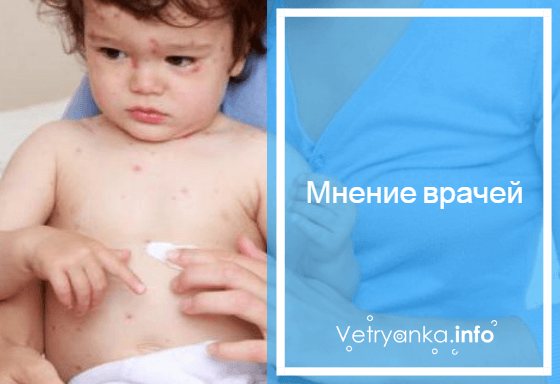
Apply brilliant green and other drugs sold at pharmacies (antiseptic) to the rash. You can also use a soda solution. But if the itching simply doesn’t give you peace, then the doctor prescribes special sedative medications (antihistamines).
Recovery can be accelerated if you resort to general recommendations that help cure the disease. You also need to carefully observe the rules of hygiene, because cleanliness plays an important role here and allows you to destroy bacteria that multiply on the body. Chickenpox in childhood is not as dangerous as in adults, however, even a child needs time to recover and return to his previous life.
Treatment of chickenpox with folk remedies
The task of parents is to reduce pain and itching throughout the course of the disease. Auxiliary treatment with folk remedies consists of externally lubricating the rash and taking baths.
- 1-2 times a day, lubricate itchy skin with a weak concentration of baking soda solution, using cotton pads, which must be changed every 5-10 cm of treated skin;
- During the day, every 3-4 hours you need to sit the child in cooling baths; At the same time, ½ cup of baking soda is poured into the bath; The duration of the bath is no more than 15 minutes;
- Alternate baths with soda with baths with potassium permanganate, dilute the water in the bath until slightly pink; duration - no more than 5 minutes, frequency - 1-2 times a day;
- Alternate baths with celandine; preparation method: pour boiling water over a handful of fresh chopped herbs, let it brew until it cools naturally, pour the infusion into the bath; bath duration: 10 minutes, frequency: 2 times a day; prepare a fresh infusion of celandine each time; it is not recommended to immediately prepare a large volume of infusion for several baths;
- A bath with chamomile infusion is also prepared; prepare a rich infusion of the herb along with stems and leaves, pour into a bath with warm water. This bath is good because you can take it in unlimited quantities and sit in it for an unlimited time, as long as the child wants.
- Along with bathing, traditional healers recommend strengthening the immune system so that the body can more successfully fight the disease. A vitamin mixture of honey and lemon juice helps speed recovery.
- The components are mixed in equal proportions immediately before use. Children should be given before meals, 1 tsp, 3 r. per day, given the absence of allergies to citrus fruits.
- When the resulting crusts begin to fall off, it is recommended to lubricate the redness on the skin with vitamin E from ampoules. You can use any unrefined sunflower oil. This treatment helps restore the skin so that “pockmarks” do not remain on the skin.
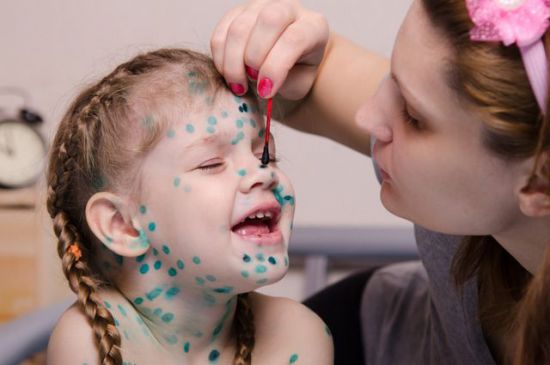
Types of chickenpox
Depending on the course of the disease, its symptoms and possible complications, chickenpox can be divided into two types:
- Typical form , which is classified by severity into mild, moderate and severe.
- Atypical form - hemorrhagic, gangrenous, visceral, rudimental, bullous, pustular.
A typical mild form of chickenpox goes away without any complications and high fever, rashes on the skin that cause itching for the child, the only manifestation of the disease, although can there be chickenpox without rashes?
Chickenpox of moderate severity manifests itself in intoxication of the body, body temperature rises to 38.5 degrees, the child may have a fever, weakness, rashes become widespread and affect the oral mucosa. When they burst, the bubbles that have ripened on the mucous membrane turn into eczema and cause a child to have a sore throat with chickenpox. Such complicated chickenpox has consequences in the form of chickenpox pneumonia and laryngitis.
Chickenpox in children under one year of age can be severe and accompanied by profuse rashes, critical temperatures, as well as atypical symptoms - vomiting and nausea associated with severe intoxication of the body. The duration of the disease in this case increases, and the likelihood of complications is also high.
Atypical forms of chickenpox are quite rare phenomena, characterized by a discrepancy between symptoms or the absence of any of them, as well as an uncharacteristic rash, which may contain blood or vary in size. In order to know everything about chickenpox, let's take a closer look at each episode of atypical chickenpox.
- Hemorrhagic chickenpox. It is observed with poor blood clotting. This type of chickenpox in children has a shortened incubation period and when the rash appears, bruises on the body can be seen. When the vesicles mature, they contain ichor mixed with blood; blood may also be present in feces and vomit. The danger of this form is that internal bleeding can occur with a fatal outcome.
- The visceral form is extremely dangerous for the life of a child, as it manifests itself in children under one year old or with very reduced immunity. Characteristic symptoms are rashes on the mucous membranes, as well as on the internal organs of the child.
- The bullous form is distinguished by special rashes - bullae, which have a dense surface, large sizes and clear outlines. Inside the bullae are filled with purulent contents, and when they burst and heal, they leave scars after chickenpox.
- Rudimental chickenpox is the mildest of the forms and types of chickenpox, which is tolerated with minimal rashes, and the shortened period of its occurrence is not overshadowed by an increase in body temperature.
- The gangrenous form can develop as a complication of the hemorrhagic one and is accompanied by necrotic tissue damage and large purulent ulcers and eczema with the addition of a bacterial infection.
- The pustular form is characterized by a long period of rashes, which are persistent and over time the liquid in them becomes mixed with pus. When pustules burst, they leave scars on the skin in the form of craters that heal over time, forming scars.
If any manifestation or symptom is atypical for chickenpox, you must inform your doctor or call an ambulance, since in children atypical forms of chickenpox develop rapidly and can have serious consequences. In this case, chickenpox treatment occurs only in a hospital infectious diseases department.
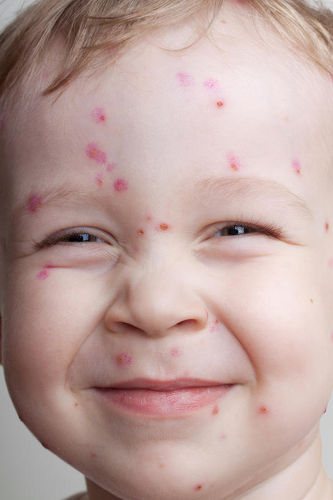
Consequences of chickenpox in a child
Regarding the external manifestations of the consequences of chickenpox in children, these are scars remaining in place of the blisters. This often occurs in those children, and even adults, who experienced suppuration and inflammation of the blisters during treatment for chickenpox.
Very severe complications are quite rare. These include inflammation of the brain - encephalomyelitis.
Congenital chickenpox is especially dangerous. Chickenpox can be avoided during pregnancy if you get vaccinated on time. Vaccinations are given to people who have never had chickenpox before. This can be determined by a special blood test. By the way, if a child has interacted with someone who has chickenpox, then there is every chance of preventing your child from developing chickenpox if you get vaccinated on time. According to research results, it is advisable to vaccinate within 48-72 hours after contact with a sick person. But is it worth “slowing down” the development of chickenpox in children in this way? Doctors are still arguing about this.
In most cases, chickenpox in children older than one year goes away without a trace, without any complications, provided proper care, of course.
How does chickenpox occur in typical forms?
Chickenpox progresses through several stages. This is explained by the peculiarities of the activity of the virus. The disease develops as follows:
- The virus enters through the mucous membranes of the mouth.
- The pathogen infects cells, causing their death.
- In place of the dead cells, a rash with serous fluid appears, which quickly spreads throughout the body.
- The immune system responds to the activity of the virus by attacking the affected cells. This leads to the formation of edema and the development of the inflammatory process.
The intensity of symptoms of the disease directly depends on the nature of the immune response. Interleukins (biological substances produced by the body in response to herpes infection) penetrate into the blood and spread throughout the body, affecting the nervous system. This provokes the occurrence of fever, in which the body temperature rises to various values.

Light form
The intensity of general symptoms is also determined by what stage of development the disease is at. Moreover, chickenpox, regardless of its form, always goes through three stages.
The first (incubation) period lasts 10-21 days. At this time, the patient does not experience any discomfort associated with the activity of the virus. The incubation period of chickenpox is characterized by the absence of pronounced symptoms.
The second (prodromal) stage lasts no more than two days. This stage of chickenpox in children manifests itself in the form of the following symptoms:
- depressed state;
- slight increase in temperature (up to 37.5 degrees);
- chills;
- itching of varying degrees of intensity;
- increased sweating;
- fatigue.
In some cases (mostly in mild forms), chickenpox in children does not provoke the appearance of the described symptoms.
At the third stage, skin rashes appear, which develop in several stages. Before acne appears with chickenpox, red spots form in the problem area, causing itching. Within a few hours, blistering formations containing serous fluid appear. During this period of chickenpox, the intensity of general symptoms reaches its maximum.
The blistering rash lasts for 2-5 days. Over time, the neoplasms open up on their own, and erosions (open wounds) appear in the problem area, which become covered with crusts. During this period, a patient with chickenpox is advised to limit contact with people. The bubbly liquid contains virus particles, which can lead to contamination of the environment.
With mild chickenpox, the described stages take place within three days. Rashes form on the body immediately, and new elements do not appear during the active course of the disease.
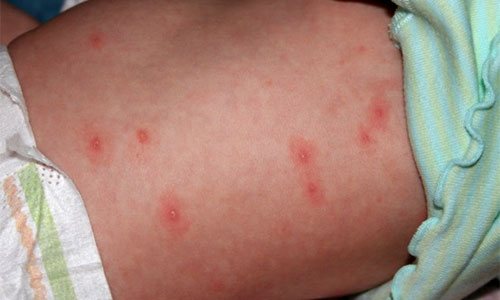
Medium form
As chickenpox develops, children develop signs of fever. This condition is a consequence of the spread of the virus throughout the body. The activity of the pathogen and the immune system provokes a rise in body temperature to 38 degrees or more. During this period, the following phenomena are often disturbing:
- decreased appetite;
- general weakness;
- headaches and muscle pain;
- sleep disturbance;
- attacks of nausea combined with vomiting.
The average form of chickenpox is poorly tolerated by children. The virus provokes a decrease in blood pressure, which negatively affects the general condition of the body. However, during the period when new rashes stop appearing, the intensity of the general symptoms will begin to subside.
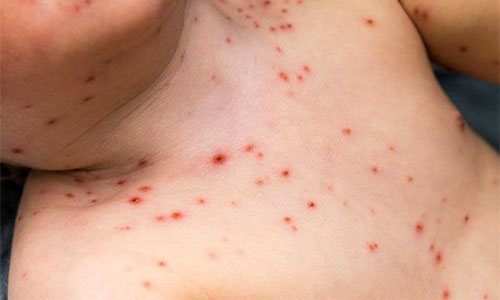
Severe form
The severe form of chickenpox in children generally becomes generalized, as a result of which the child’s temperature rises to 40 degrees. This course of the disease is usually associated with the patient's immunodeficiency state.
In severe forms of chickenpox, the rash affects not only the skin, but also the mucous membranes, digestive tract, and bronchi. The appearance of erosions at the site of the vesicles threatens the development of internal bleeding. The danger of this condition is that if the liver is damaged, the tissue begins to die.
In severe forms, individual skin rashes merge with each other, resulting in a sharp increase in the intensity of itching and pain. In this condition, children may develop a nervous breakdown.
Damage to the respiratory system, characteristic of the severe form, causes chickenpox pneumonia. The following symptoms are associated with this disease in children:
- pale or blue discoloration of the skin;
- dry cough;
- constant shortness of breath.
In severe forms, characteristic symptoms of brain inflammation (meningitis, encephalitis) also occur. Such a lesion causes impairment of consciousness. In very rare cases, chickenpox in children can cause coma. The development of acute and severe diseases of the heart, kidneys, and liver is possible, which can cause the death of the child.
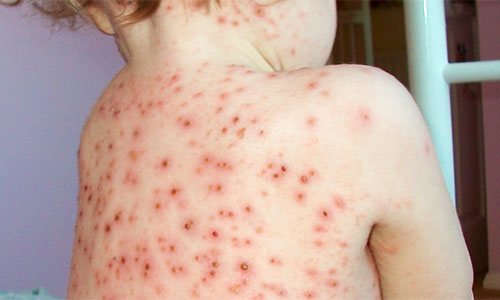
Chicken pox, regardless of the nature of its course, ends the same way. The fact that the active period of the disease has passed is indicated by a gradual decrease in the intensity of symptoms and the absence of new skin rashes. In most patients, pigment spots remain in place of the vesicles, which disappear without a trace within a few days (the duration depends on the characteristics of the lesion).
Chicken pox incubation period
The varicella zoster virus is transmitted through direct contact, airborne droplets from coughing or sneezing, and contact with contaminated clothing or bedding. The risk of catching the virus increases if the baby was in the same room as a person with chickenpox for 15 minutes, or if the baby was in close contact, such as face to face, with an infected person.
The incubation period is 7 to 21 (usually 10 to 21) days after exposure to the varicella zoster virus for symptoms to develop. The disease is most contagious a day or two before the rash appears and approximately five to six days after the rash appears. This is how chickenpox manifests itself in children in the first days after the incubation period.


